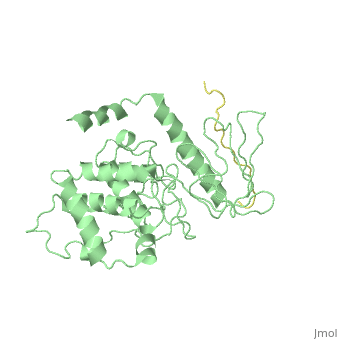|
|
| Line 3: |
Line 3: |
| | <StructureSection load='2emt' size='340' side='right'caption='[[2emt]], [[Resolution|resolution]] 2.80Å' scene=''> | | <StructureSection load='2emt' size='340' side='right'caption='[[2emt]], [[Resolution|resolution]] 2.80Å' scene=''> |
| | == Structural highlights == | | == Structural highlights == |
| - | <table><tr><td colspan='2'>[[2emt]] is a 5 chain structure with sequence from [https://en.wikipedia.org/wiki/Lk3_transgenic_mice Lk3 transgenic mice]. Full crystallographic information is available from [http://oca.weizmann.ac.il/oca-bin/ocashort?id=2EMT OCA]. For a <b>guided tour on the structure components</b> use [https://proteopedia.org/fgij/fg.htm?mol=2EMT FirstGlance]. <br> | + | <table><tr><td colspan='2'>[[2emt]] is a 5 chain structure with sequence from [https://en.wikipedia.org/wiki/Mus_musculus Mus musculus]. Full crystallographic information is available from [http://oca.weizmann.ac.il/oca-bin/ocashort?id=2EMT OCA]. For a <b>guided tour on the structure components</b> use [https://proteopedia.org/fgij/fg.htm?mol=2EMT FirstGlance]. <br> |
| - | </td></tr><tr id='related'><td class="sblockLbl"><b>[[Related_structure|Related:]]</b></td><td class="sblockDat"><div style='overflow: auto; max-height: 3em;'>[[1j19|1j19]], [[1gc6|1gc6]], [[1gc7|1gc7]], [[2d11|2d11]], [[2d10|2d10]], [[2d2q|2d2q]], [[2ems|2ems]]</div></td></tr> | + | </td></tr><tr id='method'><td class="sblockLbl"><b>[[Empirical_models|Method:]]</b></td><td class="sblockDat" id="methodDat">X-ray diffraction, [[Resolution|Resolution]] 2.8Å</td></tr> |
| | <tr id='resources'><td class="sblockLbl"><b>Resources:</b></td><td class="sblockDat"><span class='plainlinks'>[https://proteopedia.org/fgij/fg.htm?mol=2emt FirstGlance], [http://oca.weizmann.ac.il/oca-bin/ocaids?id=2emt OCA], [https://pdbe.org/2emt PDBe], [https://www.rcsb.org/pdb/explore.do?structureId=2emt RCSB], [https://www.ebi.ac.uk/pdbsum/2emt PDBsum], [https://prosat.h-its.org/prosat/prosatexe?pdbcode=2emt ProSAT]</span></td></tr> | | <tr id='resources'><td class="sblockLbl"><b>Resources:</b></td><td class="sblockDat"><span class='plainlinks'>[https://proteopedia.org/fgij/fg.htm?mol=2emt FirstGlance], [http://oca.weizmann.ac.il/oca-bin/ocaids?id=2emt OCA], [https://pdbe.org/2emt PDBe], [https://www.rcsb.org/pdb/explore.do?structureId=2emt RCSB], [https://www.ebi.ac.uk/pdbsum/2emt PDBsum], [https://prosat.h-its.org/prosat/prosatexe?pdbcode=2emt ProSAT]</span></td></tr> |
| | </table> | | </table> |
| | == Function == | | == Function == |
| - | [[https://www.uniprot.org/uniprot/RADI_MOUSE RADI_MOUSE]] Probably plays a crucial role in the binding of the barbed end of actin filaments to the plasma membrane. [[https://www.uniprot.org/uniprot/SELPL_MOUSE SELPL_MOUSE]] A SLe(x)-type glycan, which through high affinity, calcium-dependent interactions with E- and P-selectins, mediates rapid rolling of leukocytes over vascular surfaces during the initial steps in inflammation. PSGL1 is critical for the initial leukocyte capture.<ref>PMID:11104809</ref> <ref>PMID:12370362</ref> <ref>PMID:17442598</ref>
| + | [https://www.uniprot.org/uniprot/RADI_MOUSE RADI_MOUSE] Probably plays a crucial role in the binding of the barbed end of actin filaments to the plasma membrane. |
| | == Evolutionary Conservation == | | == Evolutionary Conservation == |
| | [[Image:Consurf_key_small.gif|200px|right]] | | [[Image:Consurf_key_small.gif|200px|right]] |
| Line 36: |
Line 36: |
| | </StructureSection> | | </StructureSection> |
| | [[Category: Large Structures]] | | [[Category: Large Structures]] |
| - | [[Category: Lk3 transgenic mice]] | + | [[Category: Mus musculus]] |
| - | [[Category: Hakoshima, T]] | + | [[Category: Hakoshima T]] |
| - | [[Category: Kitano, K]] | + | [[Category: Kitano K]] |
| - | [[Category: Maesaki, R]] | + | [[Category: Maesaki R]] |
| - | [[Category: Takai, Y]] | + | [[Category: Takai Y]] |
| - | [[Category: Terawaki, S]] | + | [[Category: Terawaki S]] |
| - | [[Category: Cell adhesion]]
| + | |
| - | [[Category: Protein-peptide complex]]
| + | |
| Structural highlights
Function
RADI_MOUSE Probably plays a crucial role in the binding of the barbed end of actin filaments to the plasma membrane.
Evolutionary Conservation
Check, as determined by ConSurfDB. You may read the explanation of the method and the full data available from ConSurf.
Publication Abstract from PubMed
P-selectin glycoprotein ligand-1 (PSGL-1), an adhesion molecule with O-glycosylated extracellular sialomucins, is involved in leukocyte inflammatory responses. On activation, ezrin-radixin-moesin (ERM) proteins mediate the redistribution of PSGL-1 on polarized cell surfaces to facilitate binding to target molecules. ERM proteins recognize a short binding motif, Motif-1, conserved in cytoplasmic tails of adhesion molecules, whereas PSGL-1 lacks Motif-1 residues important for binding to ERM proteins. The crystal structure of the complex between the radixin FERM domain and a PSGL-1 juxtamembrane peptide reveals that the peptide binds the groove of FERM subdomain C by forming a beta-strand associated with strand beta5C, followed by a loop flipped out towards the solvent. The Motif-1 3(10) helix present in the FERM-ICAM-2 complex is absent in PSGL-1 given the absence of a critical Motif-1 alanine residue, and PSGL-1 reduces its contact area with subdomain C. Non-conserved positions are occupied by large residues Met9 and His8, which stabilize peptide conformation and enhance groove binding. Non-conserved residues play an important role in compensating for loss of binding energy resulting from the absence of conserved residues important for binding.
Structural basis of PSGL-1 binding to ERM proteins.,Takai Y, Kitano K, Terawaki S, Maesaki R, Hakoshima T Genes Cells. 2007 Dec;12(12):1329-38. PMID:18076570[1]
From MEDLINE®/PubMed®, a database of the U.S. National Library of Medicine.
See Also
References
- ↑ Takai Y, Kitano K, Terawaki S, Maesaki R, Hakoshima T. Structural basis of PSGL-1 binding to ERM proteins. Genes Cells. 2007 Dec;12(12):1329-38. PMID:18076570 doi:10.1111/j.1365-2443.2007.01137.x
|


